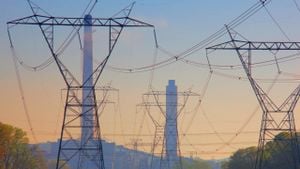September 2023 marked a significant event for both the scientific community and the residents of Greenland as a catastrophic landslide triggered a colossal wave, famously known as the mega-tsunami, reaching staggering heights of 650 feet. This event not only left local communities astonished but also resulted in mysterious global vibrations lasting nine days, baffling scientists worldwide.
Located in the isolated Dickson Fjord, this landslide was caused by the destabilization of a glacier at the base of a towering 4,000-foot mountain. The glacier had been under pressure from rising global temperatures and shrinking ice masses, leading to unprecedented conditions. Once the glacier finally succumbed to these stresses, it unleashed immense volumes of debris—enough to fill around 10,000 Olympic-sized swimming pools—into the chilly waters of the fjord.
The impact generated waves of such magnitude, reflecting off the fjord's narrow confines, creating the massive mega-tsunami. This type of natural disaster is far from ordinary; it’s the culmination of geological and climatic conditions interacting at can dramatically affect not just local ecosystems, but the global environment.
But what happened next was anything but expected. Following the massive tsunami, seismologists across the globe detected persistent ground vibrations—a phenomenon rarely seen, and one they initially thought might be due to equipment malfunction or other earthly activities. Intriguingly, these vibrations were not just any tremors; they formed a lengthy, low-frequency hum, signaling something extraordinary was at play.
This mysterious signal inspired collaboration among 68 scientists from 15 different countries who embarked on extensive analyses. They sifted through seismic readings, satellite imagery, and computer simulations, leading them to conclude these vibrations resulted from what’s known as “seiche.” This phenomenon occurs when water within confined spaces oscillates back and forth, creating rhythmic waves. The energy from the trapped tsunami waves was forced to reverberate throughout the fjord, generating the seismic energy detected globally.
Through this collaborative investigation, scientists deciphered the unusual patterns and tried to understand the broader ramifications of these shifts—even considering how interconnected our planet's systems are. Indeed, the findings serve as stark evidence of the unpredictable consequences of climate change. The event not only highlights the physical changes occurring within the Arctic but also its ramifications for human communities, local ecosystems, and the broader climate system.
The Greenland landslide and resulting tsunami have been labeled as harbingers of what may become increasingly frequent geological events due to climate change. The melting glaciers across the Arctic are reshaping landscapes, destabilizing formerly stable landmasses, and producing greater risks of such evasive natural disasters as landslides and tsunamis. Research indicates the conditions for these risks will only be exacerbated by warming temperatures.
Lena Rubensdotter, from the Geological Survey of Norway, noted, "The frequency of such disaster-triggered events could escalate as global temperatures continue to rise. We are still trying to grasp how these dynamic systems interact and how they can lead to mega-tsunamis generated from landslides." Her comments underline the urgent need for research and monitoring to comprehend and mitigate the potential threats posed by such natural disasters.
The scientific community's efforts shed light on these distinct interactions between natural processes, marking the event as one of the most compelling unsolved mysteries of modern geophysics. With increasing climatic instability and shifting ecosystems, the lessons drawn from the Greenland mega-tsunami must guide how we approach future geological assessments and climate adaptations.
Countries around the world are now under pressure to invest not only in immediate geological and climate research but also their methodologies to evolve and incorporate early warning systems capable of forecasting such hybrid natural phenomena. Governments are racing against the clock to grasp the full potential of glacier-induced landslides now threatening vulnerable coastal communities globally.
The Greenland mega-tsunami carries with it echoes of what our future may look like—a world rattled by the consequences of climate disturbances, struggling to decipher the complex dynamics between earth movements and climatic changes. Now more than ever, it's imperative for communities and leaders to heed these signals, fostering preparations for what may become astonishingly common occurrences as our planet’s climate shifts.
The resonance of both the tsunami and the mysterious vibrations exude life lessons as stern warnings about our environment's fragility. The events not only join the ranks of scientific inquiries calling out the rising tide of climate impacts but stand as reminders of humanity's place within the vast, unpredictable conduct of the natural world.
Indeed, as research continues and scientific communities reach across borders, we must remain vigilant, prepared, and adaptable to whatever conclusions arise from the dynamism of our planet, lest we ignore the vivid indications they signify. The nine-day vibration is but one chapter; the full story is still being written.



